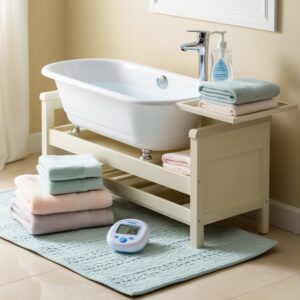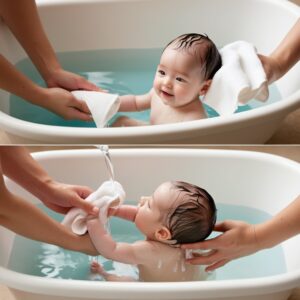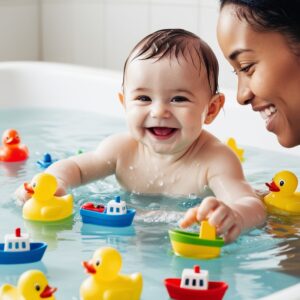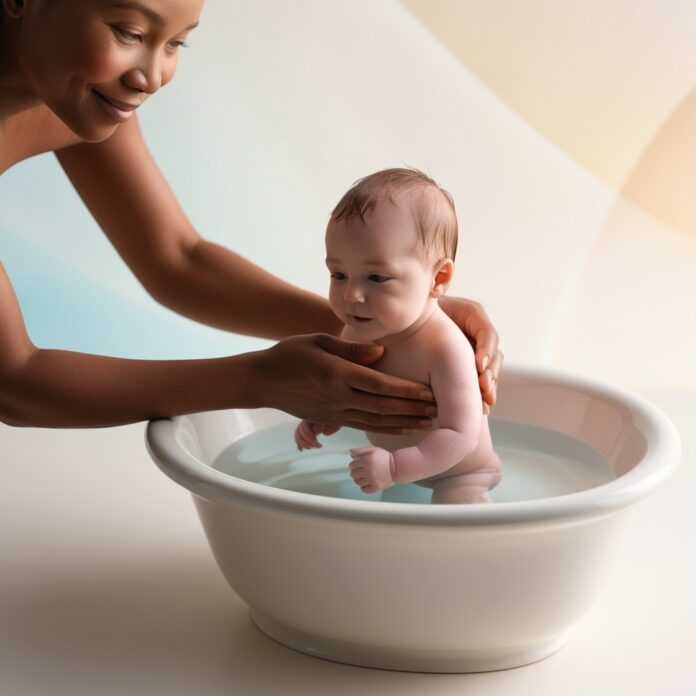The bath time with your baby can be the most magic moments of bonding. Bathing does not just clean the baby; it is also a great time when babies can play, explore their senses, and relax. On the other hand, to new parents, having a baby in the bath can sometimes be an intimidating thing. Herein, we will guide you through each step involved in the process, aid you with some safety tips, and share the best practices so that bath time can indeed be comfortable and safe for both you and your little one. With the right approach, mastery of this time with the baby is really a treasured routine.
1. When to Start Bathing Your Newborn
Newborns don’t require too many baths to start with, anyway. In fact, until the stump of the umbilical cord falls off, stick to sponge bathing. Here’s all you need to know:
- Sponge Baths: A soft cloth is used lightly to clean an infant’s face and neck and body. These delicate areas can be just cleaned with warm water, with no soap in the first few days.
- Frequency of Bathing: You may bathe your baby two to three times a week after the stump of the umbilicus falls off. Overbathing may cause dryness on sensitive baby skin.
2. Preparing the Environment for Safe Bathing
Bathing calls for safety to be taken into great concern when dealing with your baby. The preparation done before bathing will ensure a smooth experience.
- Position Correctly: Choose a baby bath or clean sink in which the water level should be shallow and of low intensity. The use of a full-size bathtub is out of the question since it will be nearly impossible to control.
- Water Temperature: It should be warm, not hot; actually, around 98.6°F (37°C). It can be tested by using either the wrist or elbow since these surfaces are more sensitive.
- Get all the necessities in hand: baby soap, washcloths, a cup for rinsing, and a soft towel.

3. Steps in Bathing Your Baby
It is easier to bathe a baby if broken down into simple steps. Here is an easy routine to bathe your baby with:
- Undress and Wrap: Remove clothes from the baby and wrap him with a towel for warmth.
- Face Washing: Wipe the face of your baby with a clean and damp cloth, paying extra attention to the eyes, nose, and mouth. There is no requirement of any soap here.
- Body Cleaning: Next, with a soft washcloth and a very small amount of fragrance-free mild baby soap, gently wash the neck, arms, and legs, and then rinse with a cup of water.
- Rinse Carefully: Permit water to run over his body, gentle enough not to splash the water all over, and to just rinse the soap off his body.
- Dry and Moisturize: Gently pat the skin dry with a soft towel, then apply some light baby lotion, if necessary, in order to keep it from drying out.

4. Choosing the Right Products
It is very important to make use of gentle products designed just for babies. A few products one could use are as follows:
- Baby Soap and Shampoo: Mild and unscented are usually best; fragrances can irritate the sensitive skin of babies.
- Moisturizers: Generally speaking, it is not necessary to apply any heavy creams on babies; if skin seems dry, a hypoallergenic baby lotion can be applied lightly.
- Towels and Washcloths: Soft and absorbent materials are the best because these are gentle on their fragile skin.

5. Making Bath Time Fun and Engaging
Bath time does not have to be a chore but can be one of those moments for bonding and playing. Here’s how to make it an enjoyable time for both you and your baby:
- Use Toys: Soft rubber toys or bath books can make bath time interactive. Just make sure any toys are safe, free from small parts, and easy to clean.
- Talk and Sing: Talking to your baby or even singing keeps him relaxed and comfortable. He likes familiar voices and this gives a great opportunity for play.
- Splashing and Gentle Pouring: Babies love water sensation and should be allowed to play by light splashing with hands or pouring limited water from a cup.

6. Safety Tips for Bath Time Routine
Safety should be your top priority during bath time. Following are some tips to help you provide a safe environment:
- Never Leave Your Baby Unattended: The babies may slip or swallow water in no time, so one hand is always to be kept on them, and never leave them alone, not even for a while.
- Check Water Depth: Allow only a shallow level of water, say about 2–3 inches, which would do fine for infants.
- Watch out for slips: Babies are slippery when wet! You may want to consider using a non-slip mat if using a bath tub.
7. Bed Time Bath Routine
There are many ways in which an established bath time routine can help your baby feel more relaxed heading into bedtime and appreciate predictability.
- Create a Bath Time Routine: Choose a time when your baby is most relaxed and awake. For many parents, an evening bath calms their baby down before bedtime.
- Stick to Routine: Predictability plays very comfortably with babies.
- Treat Bath Time as Wind-Down Time: If the bath time falls just before bedtime, try keeping it really gentle and low-key. Soft music or dim lighting can help create this atmosphere.

Baby bath time is all about preparation, taking your time, and creating a soothing experience for them. With confidence, this could be an altogether pleasurable time spent in bonding on a day-to-day basis-a time of hygiene not only but also of playing and relaxing together, as well. This could be the best part of your baby’s day that they will look ahead to by following all these steps and making the practices safe and gentle. And with every step, remember that it is all about the journey-every splash, every giggle that goes into making memories with the little one.



